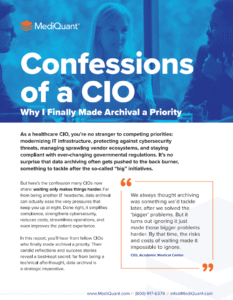
Your Next EHR Starts with a Clean Cerner Exit
Moving from Oracle Health/Cerner isn’t just about migrating data. It’s your shot at building clinician trust, actualizing significant savings, and positioning IT as drivers of transformation. Don’t let fragmented files, flat data or inconsistent builds put your project at risk.
Whether you’re consolidating applications, retiring Cerner, or transitioning between environments, MediQuant offers Cerner-specific expertise paired with strategic data management solutions that help you own your organization’s exit confidently.
Cerner Experience You Can Build a Strategy on
25 + years
of healthcare data expertise
5,000+
successful Cerner migrations completed
98%
of projects delivered on time

Helping You Avoid Common Pitfalls in Cerner to Epic Migration
Cerner environments can be a maze of flat files, interfaces, custom modules, and inconsistent builds, especially in Millennium where data is often scattered across multiple locations. When the transition of legacy data causes workflow gaps, timeline slips or clinical confusion, the consequences can be dire.
Here’s how we protect you from the most common Cerner migration challenges:
Pitfall
Fragmented builds across environments
Legacy flat files and inaccessible data
Slow extractions via Cerner CCL
Data corruption or loss during transfer
Unclear retention strategy
Gaps in project visibility or ownership
Our Fix
Playbooks for CommunityWorks, Millennium, and custom configurations. We decode site-level logic, clean inconsistencies, and extract data even when documentation falls short.
Millennium includes over 3,200 flat files buried across directories. Our RMAN engine extracts directly from Oracle backups for complete and accurate access.
We bypass CCL limitations with RMAN + SQL, enabling faster, more complete extractions.
Structured validation at every phase ensures clean, usable data goes live.
We define policies aligned with HIPAA and regulations, ensuring archived data remains accessible and compliant.
Dedicated project managers, clear timelines, and aligned responsibilities keep migrations on track.
Ready to reclaim control over your Cerner to Epic migration?
Book a strategy call today and get a clear, customized plan.
Who We Help

Enterprise Health Systems: Retire multiple Cerner environments, centralize records, and enable data-driven decision-making.

Community Hospitals: Transition cleanly from CommunityWorks without losing continuity or compliance.

Ambulatory & Specialty Clinics: Handle niche workflows, perioperative records, and departmental modules with confidence.

Academic Medical Centers: Support hybrid transitions and research data extraction across years of history.

Children’s Hospitals: Preserve pediatric workflows and critical patient histories without disrupting care.
End-to-End Cerner to Epic Migration Solutions
Fast, Accurate Extraction for Even the Most Complex Cerner Builds
MediQuant delivers enterprise-grade expertise across the full Cerner stack, no matter the application age, sprawl, or access method. We’ve built our own RMAN engine to bypass CCL bottlenecks, extract across Oracle SQL, and capture complete datasets at scale. Whether it’s clinical, financial, or administrative records, we know where it lives, how to access it, and how to make it clean.

88 %
of our team members have Cerner module experience
Smooth EHR Data Conversion. Risk-Controlled Migration.
We don’t just migrate your Cerner data. We make sure it’s usable. That means translating every high-priority field with Cerner-specific logic, catching alignment issues early, and validating multiple iterations with your HIM and IT teams. The result: clean, de-duped, production-ready data that protects clinical continuity and minimizes risk at go-live.
Smart Data Archiving for Critical App Retirement and Secure Record Retention
DataArk® delivers secure, centralized access to active and historical records from a single active data archiving platform, fully integrated into your live EHR.
Ready to see DataArk in action? Schedule a demo.
For smaller orgs or less complex data sets, CommunityArk™ brings the same compliance, and audit-ready access, right-sized for physician practices, clinics, and ambulatory facilities.
Take a closer look at CommunityArk. Schedule a demo.
Built for Cerner. Backed by Experience.
With more than 5,000 Cerner client projects under our belt, we’ve worked inside some of the most customized and complex configurations, from interfaced surgical flowsheets to orphaned scanned documents, and made them usable, validated, and accessible.
Our team of Cerner experts includes:
- Former health system data leads who’ve owned Cerner transitions from the inside
- Clinical informatics advisors who ensure converted data still makes sense to the people using it
- Specialists fluent in data extraction techniques and tools to handle the quirks of modules like PathNet, SurgiNet, and FirstNet
- Compliance analysts who audit against HIPAA and other retention standards
Cerner Modules We Know Inside and Out
Our Cerner experts have extracted, validated, and mapped the most challenging Cerner instances having worked with virtually every Cerner application and module in the market, including:

CAMM

Cerner Document Management

Cerner Specialty Practice Management (PM)

CommunityWorks

CoPath

Cerner Document Management

EDM

FetalLink

Ideal

Invision

Magic

MedSeries4

Millenium ProFit (PA module)

Millennium Clinical

Millennium Pathnet

Novius Lab

P2 Sentinel

Parallon

Pharmacy

PowerWorks

Radnet

Siemens Pharmacy

Signature

Soarian (Clinicals, Financials, Scheduling)

SurgiNet

Syngo Radiology
Real Results from High-Stakes Cerner Transitions
Mosaic Life Care
7 Months. Millions Saved. Zero Disruption.
Faced with an urgent Epic deadline, Mosaic chose MediQuant to archive its complex Cerner environment. We beat every vendor’s timeline—delivering in just seven months, with full clinical trust intact.

$14M Saved. 60+ Migrations. One System-wide Strategy.
Post-merger, Prisma needed to archive Cerner data from 18 hospitals and 5,200+ clinicians. MediQuant delivered 60+ archives, saving Prisma $14M annually, while making legacy data accessible inside Epic.
Your Next Move Doesn’t Start with a Demo. It Starts with a Plan.
Your transition involves more than simply “replacing Cerner.” It’s your chance to reclaim your data, reduce long-term risk, and lay the groundwork for what’s next—on your terms.
Book a strategy call and get started mapping out your organization’s first step
Frequently Asked Questions
What’s the difference between a conversion and a migration?
Migration refers to the full data move from one application to another. Conversion is a specific process within the larger migration where data is transformed into a format usable by the new application.
What types of data or applications are typically converted during a Cerner migration?
Clinical, financial, and administrative data—including both discrete (structured) and non-discrete (unstructured) formats. (This includes healthcare data conversion and medical data conversion as needed.)
How do you ensure data accuracy during conversion?
We follow best practices for Cerner validation, involving Small-Scale, Large-Scale, and Full-Scale phases. At each stage, MediQuant provides validation workbooks to guide your team through the process.
How long does a Cerner migration take?
Timelines vary based on project scope but typically range from 9–12 months, depending on:
- Number and complexity of source applications
- Access to source databases
- Scope and volume of data
- Types of data being converted
What makes Cerner extraction so different from Epic or MEDITECH?
Cerner’s modular architecture is highly customized and often inconsistently deployed across orgs. It’s not just one EHR; it’s usually many, stitched together.
What types of data can be extracted?
Structured, unstructured, scanned documents, attachments across clinical, financial, and administrative domains.
Do you support legacy Cerner builds?
Yes. We’ve worked with Classic, Millennium, CommunityWorks, and everything in between including acquired environments and regional hybrids.
Do you support transitions into or out of CommunityWorks?
Both. Whether you’re expanding into it or moving out, we’ve done it, and we know what to look out for.
What are key roles and responsibilities in a Cerner conversion or migration?
A typical project team includes:
- Project Manager (PM): Oversees the project timeline, budget, and team coordination.
- Implementation Consultant (IC): Provides expert guidance on application implementation.
- Interface Project Manager: Manages interface setup and integration (if interfaces are being implemented).
- Extractor: Handles data extraction from legacy applications.
- Data Conversion Specialist: Performance transformation and conversion data from legacy application to the new application
Your next move starts with a demo and a plan.
Book a strategy call today to start planning your Cerner to Epic migration.
Contact Us Today
We’d love to hear from you!



